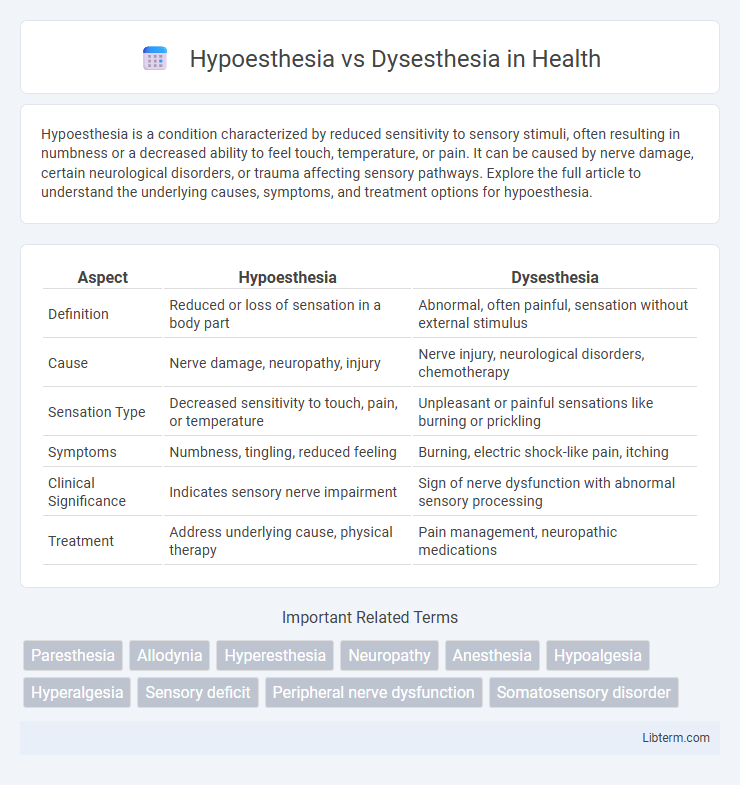Hypoesthesia is a condition characterized by reduced sensitivity to sensory stimuli, often resulting in numbness or a decreased ability to feel touch, temperature, or pain. It can be caused by nerve damage, certain neurological disorders, or trauma affecting sensory pathways. Explore the full article to understand the underlying causes, symptoms, and treatment options for hypoesthesia.
Table of Comparison
| Aspect | Hypoesthesia | Dysesthesia |
|---|---|---|
| Definition | Reduced or loss of sensation in a body part | Abnormal, often painful, sensation without external stimulus |
| Cause | Nerve damage, neuropathy, injury | Nerve injury, neurological disorders, chemotherapy |
| Sensation Type | Decreased sensitivity to touch, pain, or temperature | Unpleasant or painful sensations like burning or prickling |
| Symptoms | Numbness, tingling, reduced feeling | Burning, electric shock-like pain, itching |
| Clinical Significance | Indicates sensory nerve impairment | Sign of nerve dysfunction with abnormal sensory processing |
| Treatment | Address underlying cause, physical therapy | Pain management, neuropathic medications |
Understanding Hypoesthesia: Definition and Causes
Hypoesthesia is characterized by a reduced sense of touch or decreased sensitivity to sensory stimuli, often resulting from nerve damage, neurological disorders, or trauma. Common causes include peripheral neuropathy, multiple sclerosis, and localized nerve compression, which impair normal sensory signal transmission. Identifying hypoesthesia involves clinical evaluation and diagnostic testing to determine the underlying condition and guide appropriate treatment.
What Is Dysesthesia? Key Features and Origins
Dysesthesia is a neuropathic condition characterized by unpleasant, abnormal sensations such as burning, electric shocks, or tingling, often caused by nerve damage or central nervous system disorders. Key features include spontaneous or provoked painful sensations that can significantly impact quality of life and are commonly associated with diseases such as multiple sclerosis, diabetic neuropathy, or postherpetic neuralgia. Dysesthesia originates from dysfunctional sensory nerve fibers or altered central processing of sensory signals, resulting in distorted perception of touch or pain.
Comparing Hypoesthesia and Dysesthesia: Core Differences
Hypoesthesia is characterized by a reduced sensitivity to sensory stimuli, resulting in numbness or decreased sensation, often caused by nerve damage or neurological conditions. Dysesthesia involves abnormal, often unpleasant sensations such as burning, itching, or tingling, typically arising from neuropathic disorders or peripheral nerve injuries. The core difference lies in hypoesthesia representing diminished sensory input, whereas dysesthesia reflects distorted or painful sensory perception despite normal or heightened stimulus detection.
Common Symptoms of Hypoesthesia
Hypoesthesia is characterized by a decreased sensitivity to sensory stimuli, leading to numbness or reduced touch sensation in affected areas, while dysesthesia involves abnormal and often unpleasant sensations such as burning or tingling. Common symptoms of hypoesthesia include partial or complete loss of feeling, diminished response to temperature changes, and impaired pain perception. These sensory deficits often result from nerve damage or neurological disorders and can significantly affect daily activities.
Dysesthesia: Symptoms and Patient Experiences
Dysesthesia is characterized by abnormal sensations such as burning, tingling, or electric shock-like feelings, often experienced without external stimuli, significantly impacting patients' quality of life. Symptoms can vary in intensity and may include pain, itching, or a crawling sensation that is frequently distressing and persistent. Patients frequently report dysesthesia as more disruptive compared to hypoesthesia, which involves numbness or reduced sensitivity, highlighting the complex sensory disturbances in neurological conditions like multiple sclerosis or peripheral neuropathy.
Underlying Conditions Linked to Hypoesthesia
Hypoesthesia, characterized by reduced sensation or numbness, is commonly linked to underlying conditions such as peripheral neuropathy, multiple sclerosis, and stroke. These disorders disrupt normal nerve function, leading to diminished sensory perception in affected areas. Identifying the root cause is crucial for targeted treatment and symptom management.
Medical Disorders Associated with Dysesthesia
Dysesthesia is commonly linked to neurological conditions such as multiple sclerosis, peripheral neuropathy, and postherpetic neuralgia, where patients experience abnormal and often painful sensations. Unlike hypoesthesia, which primarily involves reduced sensation or numbness due to nerve damage or spinal cord injury, dysesthesia involves unpleasant, often burning or electric shock-like feelings triggered by normally non-painful stimuli. Medical disorders associated with dysesthesia highlight the complexity of nerve dysfunction, emphasizing the need for accurate diagnosis and targeted treatment to manage these debilitating sensory symptoms.
Diagnostic Approaches for Sensory Disorders
Hypoesthesia is characterized by a reduced sense of touch or sensation, whereas dysesthesia involves abnormal and often unpleasant sensations. Diagnostic approaches for these sensory disorders primarily include detailed patient history, neurological examination, and quantitative sensory testing (QST) to evaluate sensory thresholds. Advanced imaging techniques such as MRI and nerve conduction studies help identify underlying causes, providing critical information to differentiate between peripheral and central nervous system involvement.
Treatment Options for Hypoesthesia and Dysesthesia
Treatment options for hypoesthesia focus on addressing the underlying cause, such as nerve compression or injury, often employing physical therapy, medications like corticosteroids, or surgical interventions. Dysesthesia management typically involves neuropathic pain medications including gabapentin, pregabalin, or tricyclic antidepressants to reduce abnormal sensory perceptions. Both conditions may benefit from complementary therapies like transcutaneous electrical nerve stimulation (TENS) and lifestyle modifications tailored to symptom severity.
Living with Sensory Changes: Coping and Management Tips
Hypoesthesia involves reduced sensation, while dysesthesia causes unpleasant, abnormal sensations, both significantly impacting daily life. Effective coping strategies include consistent use of prescribed medications, physical therapy to maintain sensory function, and mindfulness techniques to manage discomfort. Creating a structured routine with regular sensory stimulation exercises can improve neural adaptation and enhance overall quality of life.
Hypoesthesia Infographic

 libterm.com
libterm.com